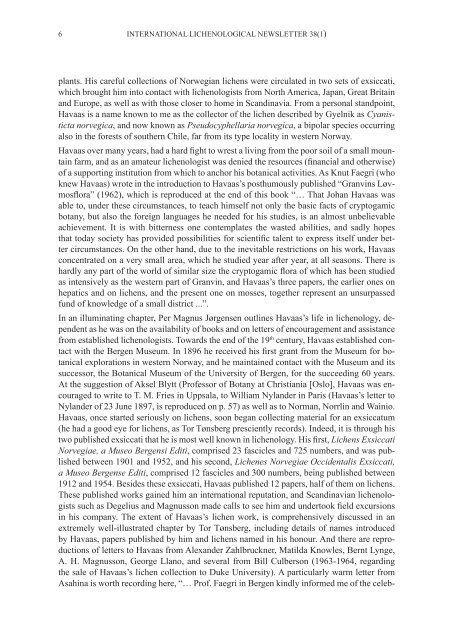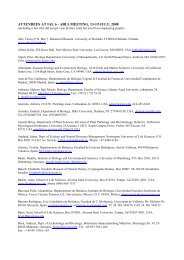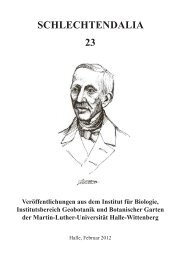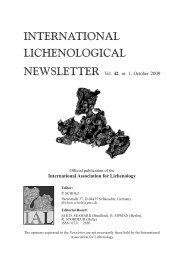NEWS - International Association for Lichenology
NEWS - International Association for Lichenology
NEWS - International Association for Lichenology
Create successful ePaper yourself
Turn your PDF publications into a flip-book with our unique Google optimized e-Paper software.
6 INTERNATIONAL LICHENOLOGICAL <strong>NEWS</strong>LETTER 38(1)<br />
plants. His careful collections of Norwegian lichens were circulated in two sets of exsiccati,<br />
which brought him into contact with lichenologists from North America, Japan, Great Britain<br />
and Europe, as well as with those closer to home in Scandinavia. From a personal standpoint,<br />
Havaas is a name known to me as the collector of the lichen described by Gyelnik as Cyanisticta<br />
norvegica, and now known as Pseudocyphellaria norvegica, a bipolar species occurring<br />
also in the <strong>for</strong>ests of southern Chile, far from its type locality in western Norway.<br />
Havaas over many years, had a hard fi ght to wrest a living from the poor soil of a small mountain<br />
farm, and as an amateur lichenologist was denied the resources (fi nancial and otherwise)<br />
of a supporting institution from which to anchor his botanical activities. As Knut Faegri (who<br />
knew Havaas) wrote in the introduction to Havaas’s posthumously published “Granvins Løvmosfl<br />
ora” (1962), which is reproduced at the end of this book “… That Johan Havaas was<br />
able to, under these circumstances, to teach himself not only the basic facts of cryptogamic<br />
botany, but also the <strong>for</strong>eign languages he needed <strong>for</strong> his studies, is an almost unbelievable<br />
achievement. It is with bitterness one contemplates the wasted abilities, and sadly hopes<br />
that today society has provided possibilities <strong>for</strong> scientifi c talent to express itself under better<br />
circumstances. On the other hand, due to the inevitable restrictions on his work, Havaas<br />
concentrated on a very small area, which he studied year after year, at all seasons. There is<br />
hardly any part of the world of similar size the cryptogamic fl ora of which has been studied<br />
as intensively as the western part of Granvin, and Havaas’s three papers, the earlier ones on<br />
hepatics and on lichens, and the present one on mosses, together represent an unsurpassed<br />
fund of knowledge of a small district ...”.<br />
In an illuminating chapter, Per Magnus Jørgensen outlines Havaas’s life in lichenology, dependent<br />
as he was on the availability of books and on letters of encouragement and assistance<br />
from established lichenologists. Towards the end of the 19th century, Havaas established contact<br />
with the Bergen Museum. In 1896 he received his fi rst grant from the Museum <strong>for</strong> botanical<br />
explorations in western Norway, and he maintained contact with the Museum and its<br />
successor, the Botanical Museum of the University of Bergen, <strong>for</strong> the succeeding 60 years.<br />
At the suggestion of Aksel Blytt (Professor of Botany at Christiania [Oslo], Havaas was encouraged<br />
to write to T. M. Fries in Uppsala, to William Nylander in Paris (Havaas’s letter to<br />
Nylander of 23 June 1897, is reproduced on p. 57) as well as to Norman, Norrlin and Wainio.<br />
Havaas, once started seriously on lichens, soon began collecting material <strong>for</strong> an exsiccatum<br />
(he had a good eye <strong>for</strong> lichens, as Tor Tønsberg presciently records). Indeed, it is through his<br />
two published exsiccati that he is most well known in lichenology. His fi rst, Lichens Exsiccati<br />
Norvegiae, a Museo Bergensi Editi, comprised 23 fascicles and 725 numbers, and was published<br />
between 1901 and 1952, and his second, Lichenes Norvegiae Occidentalis Exsiccati,<br />
a Museo Bergense Editi, comprised 12 fascicles and 300 numbers, being published between<br />
1912 and 1954. Besides these exsiccati, Havaas published 12 papers, half of them on lichens.<br />
These published works gained him an international reputation, and Scandinavian lichenologists<br />
such as Degelius and Magnusson made calls to see him and undertook fi eld excursions<br />
in his company. The extent of Havaas’s lichen work, is comprehensively discussed in an<br />
extremely well-illustrated chapter by Tor Tønsberg, including details of names introduced<br />
by Havaas, papers published by him and lichens named in his honour. And there are reproductions<br />
of letters to Havaas from Alexander Zahlbruckner, Matilda Knowles, Bernt Lynge,<br />
A. H. Magnusson, George Llano, and several from Bill Culberson (1963-1964, regarding<br />
the sale of Havaas’s lichen collection to Duke University). A particularly warm letter from<br />
Asahina is worth recording here, “… Prof. Faegri in Bergen kindly in<strong>for</strong>med me of the celeb-






